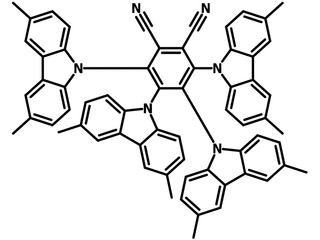4CzPN-Me
CAS Number 1469700-28-4
Dopant Materials, Green Dopant Materials, Materials, OLED Materials, Semiconducting Molecules, TADF MaterialsA highly efficient TADF green emitter
Family member of carbazolyl benzonitriles (CBC) which are well known, highly efficient thermally activated delayed fluorescence (TADF) materials.
Specifications | MSDS | Literature and Reviews
4CzPN-Me, namely 3,4,5,6-tetrakis(3,6-dimethylcarbazol-9-yl)- 1,2-dicyanobenzene, is a fully methylated derivative of 4CzPN at 3,6-positions with four carbazole moieties either next or opposite to the cyano groups. The methyl groups on each of the carbazolyl moieties not only increase the solubility of 4CzPN-Me while comparing with 4CzPN by the introduction of solubilizing alkyl groups with enhanced steric effect, but also enrich the electron density of the carbazole units around the benzene ring.
Also comparing with 4CzPN, the photoluminescence of 4CzPN-Me is red-shifted due to the higher degree of electron density and conjugation.
General Information
| CAS Number | 1469700-28-4 |
| Full Name | 3,4,5,6-tetrakis(3,6-dimethylcarbazol-9-yl)- 1,2-dicyanobenzene |
| Synonyms | 3,4,5,6-tetrakis(3,6-dimethyl-9H-carbazol-9-yl)phthalonitrile |
| Chemical Formula | C64H48N6 |
| Molecular Weight | 901.11 g/mol |
| Absorption | N/A |
| Fluorescence | λem 552 nm in toluene |
| HOMO/LUMO | HOMO = ~5.8 eV, LUMO = ~3.4 eV (estimated with 4CzPN as reference) |
| Classification / Family | Carbazole, TADF materials, Green dopant materials, Sublimed materials |
Chemical Structure

Product Details
| Purity | Unsublimed >98.0% 1H NMR) |
| Melting Point | N/A |
| Appearance | Orange powder/crystals |
MSDS Documentation
Literature and Reviews
- Observation of Nonradiative Deactivation Behavior from Singlet and Triplet States of Thermally Activated Delayed Fluorescence Emitters in Solution, N. Notsuka et al., J. Phys. Chem. Lett., 11 (2), 562–566 (2020); DOI: 10.1021/acs.jpclett.9b03302.
